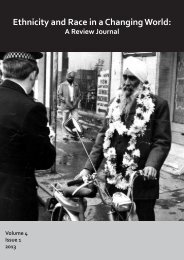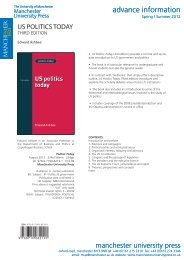Ethnicity and Race in a Changing World
Volume 2, Issue 1, 2011 - Manchester University Press
Volume 2, Issue 1, 2011 - Manchester University Press
Create successful ePaper yourself
Turn your PDF publications into a flip-book with our unique Google optimized e-Paper software.
<strong>Ethnicity</strong> <strong>and</strong> <strong>Race</strong> <strong>in</strong> a Chang<strong>in</strong>g <strong>World</strong>: A Review JournalSocialist Cuba. Unpublished PhD dissertation, University of Chicago, 2004.36. Lowenhaupt Ts<strong>in</strong>g, A. In The Realm of the Diamond Queen. Pr<strong>in</strong>cetown: Pr<strong>in</strong>cetown University Press, 199337. The museum narrative conta<strong>in</strong>s its own gaps <strong>and</strong> silences. The Castillo rema<strong>in</strong>ed <strong>in</strong> use as a prison untilthe 1980s, a fact that is not mentioned by the guides who take visitors to see the cells where slaveswere kept. I am <strong>in</strong>debted to Julio Moracen Naranjo <strong>and</strong> Andres Reyes Rodriguez for supplement<strong>in</strong>g myunderst<strong>and</strong><strong>in</strong>g of the site.38. On the several occasions that I have taken one of the higher-priced air-conditioned buses that runbetween Havana <strong>and</strong> Varadero, I was one of the few people who disembarked at Matanzas.39. Costumbrismo is a form of literary or visual representation that focuses on scenes of everyday life, or“local color”. It is derived from the Spanish word for customs -- costumbres.40. The manifold ironies of the market<strong>in</strong>g of Che have been dissected by numerous scholars, <strong>in</strong>clud<strong>in</strong>g ArianaHern<strong>and</strong>ez-Reguant - see Hern<strong>and</strong>ez-Reguant, A. Copyright<strong>in</strong>g Che: Art <strong>and</strong> Authorship under LateCuban Socialism. Public Culture 2004 16(1) pp. 1-30; Skoller, J. The Future's Past: Re-imag<strong>in</strong>g the CubanRevolution. Afterimage. 26. 199941. The complexities of museumized representations of Afrocuban religions are discussed by Luis Pedroso.Las exposiciones de ‘cultos afrocubanos (ref. 27). A more detailed analysis of the ethnographic displays <strong>in</strong>the Museo de Guanabacoa can be found <strong>in</strong> Lisa Maya Knauer, “Afrocuban Religion <strong>in</strong> Cuban Museums” <strong>in</strong>Daniel Walkowitz <strong>and</strong> Lisa Maya Knauer, eds. Contest<strong>in</strong>g History <strong>in</strong> Public Space (ref 28)42. The imbrication of carnivalistic <strong>and</strong> ethnographic is not unique to Cuba: I purchased my Barbadian“Mammy” doll from the gift shop at the National Museum.43. See Kutz<strong>in</strong>ski, V. Sugar’s Secrets: <strong>Race</strong> <strong>and</strong> the Erotics of Cuban Nationalism. Charlottesville: UniversityPress of Virg<strong>in</strong>ia, 199344. I want to thank Tomas Fern<strong>and</strong>ez Roba<strong>in</strong>a for po<strong>in</strong>t<strong>in</strong>g me <strong>in</strong> the direction of the L<strong>and</strong>aluze pa<strong>in</strong>t<strong>in</strong>gs <strong>in</strong>the Museo de Bellas Artes.45. In most of the African-derived religions practiced <strong>in</strong> Cuba, white represents purity, <strong>and</strong> participants <strong>in</strong>religious ceremonies often wear white or light colors. In la regla de ocha (santeria), new <strong>in</strong>itiates (iyawos)dress exclusively <strong>in</strong> white for a year, <strong>and</strong> <strong>in</strong> both ocha <strong>and</strong> the Congo-derived practices colloquiallyreferred to as palo monte or simply palo, <strong>in</strong>itiates wear beaded necklaces that represent specific guardianspirits or div<strong>in</strong>ities (called orishas <strong>in</strong> la regla de ocha <strong>and</strong> nkisi <strong>in</strong> palo). Cigars have many uses <strong>in</strong> religiouscontexts. Certa<strong>in</strong> orishas, <strong>and</strong> eguns or muertos (spirits of the deceased) favor cigars, <strong>and</strong> participants <strong>in</strong>religious ceremonies frequently smoke cigars <strong>in</strong> an effort to attract those deities or spirits, or place cigarson their home altars. There are several reliable sources on Afrocuban religious practices <strong>and</strong> symbolism,<strong>in</strong>clud<strong>in</strong>g Mason, M. Liv<strong>in</strong>g Santeria: Rituals <strong>and</strong> Experiences <strong>in</strong> an Afro-Cuban Religion. Wash<strong>in</strong>gton,DC: Smithsonian Institution, 1992. <strong>and</strong> Ramos, M. The Lukumi Pantheon: The Orishas Worshipped by theLukumi. [Onl<strong>in</strong>e] (Retrieved on 8 July 2009] Url: http://ilarioba.tripod.com/articlesm<strong>in</strong>e/Pantheon.htm.46. Most of the staged performances of music <strong>and</strong> dance from the palo/Kongo traditions depict scenes ofslaves be<strong>in</strong>g brutalized by their masters or overseers (as all the performers are black), <strong>and</strong> then b<strong>and</strong><strong>in</strong>gtogether <strong>and</strong> us<strong>in</strong>g spiritual powers to vanquish their oppressors <strong>and</strong> liberate themselves. See Moore, R.(ref. 3) for a discussion of the role of black musicians <strong>in</strong> the n<strong>in</strong>eteenth <strong>and</strong> twentieth centuries.47. I have not found a widely-used Cuban name for these dolls. Some have suggested that the label “la negraFrancisca” is often used.48. Lane, J. Blackface Cuba, 1840-1895. Philadelphia: University of Pennsylvania Press, 2005. My read<strong>in</strong>g ofthe marquillas draws upon Kutz<strong>in</strong>ski’s analysis, <strong>in</strong> Sugar’s Secrets (ref. 43), <strong>and</strong> that of Alison Fraunhar- see Fraunhar, A. Marquillas cigarreras cubanas: Nation <strong>and</strong> Desire <strong>in</strong> the N<strong>in</strong>eteenth Century. HispanicResearch Journal. 9(5), 2008, pp. 458-478. For a fuller discussion of the “mammy” or “Aunt Jemima”image <strong>in</strong> U.S. popular culture <strong>and</strong> racial imag<strong>in</strong><strong>in</strong>gs, see Turner, Patricia A. Ceramic Uncles & CelluloidMammies: Black Images <strong>and</strong> Their Influence on Culture. New York: Anchor Books, 1994.; <strong>and</strong> Wallace-Saunders, K. Mammy: A Century of <strong>Race</strong>, Gender <strong>and</strong> Southern Memory. Ann Arbor: University of MichiganPress, 2006. An early treatment of the subject can be found <strong>in</strong> Dub<strong>in</strong>, Steven C. Symbolic Slavery: BlackRepresentations <strong>in</strong> Popular Culture. Social Problems, 34(2) 1987, pp. 122-140.49. One of the most explicit depictions of the racial <strong>and</strong> gender codes is a series entitled “The Birth of theMulata”, which beg<strong>in</strong>s with the sexual relationship between white man <strong>and</strong> black woman, <strong>and</strong> progressesthrough the “com<strong>in</strong>g out” of the mulata as an allur<strong>in</strong>g young woman. See Kutz<strong>in</strong>ski, Sugar’s Secrets, (ref.3.)50. See Kirshenblatt-Gimblett In: Karp, I <strong>and</strong> Lav<strong>in</strong>e, S. eds. (ref. 9 pp. 386-443). Accord<strong>in</strong>g to the directorof the Museo Histórico de Guanabacoa, many of the museum’s early acquisitions of Afrocuban22






